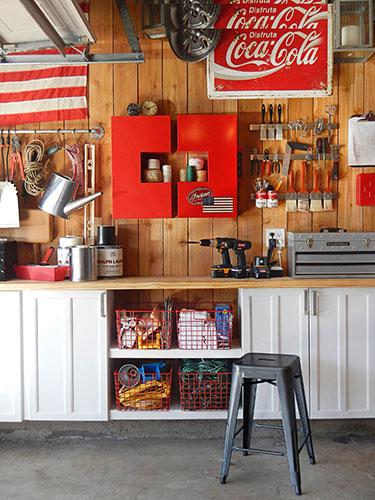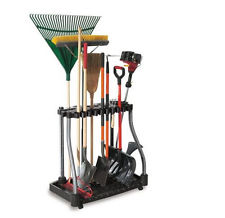Due to the variations of temperature and the unfinished spaces, garages and sheds are best suited for storing equipment and supplies that are normally used outside. Organizing a garage or a shed is a matter of “sectionalizing.” Each type of equipment or product will get a specific section of wall or floor space, clearly separate from other sections.
To start, pull everything out of the garage/shed. Get rid of the items you don’t need and determine what actually should stay in the garage. Separate the garage or shed into zones and determine what should be placed in each section.
Recycling Center:
Putting the recycling center by the door is the most convenient location. Next, choose containers to best sort the type of recyclables (if this is required by your municipality). If you need to sort out the recyclables by type, it would be best to color code the containers so there is no confusion.
Hand Tools:
 Organizing hand tools is essential to making your life easier, especially when it comes to the small articles and pieces that get lost very easily. Before organizing, ask yourself these questions about your inventory of hand tools:
Organizing hand tools is essential to making your life easier, especially when it comes to the small articles and pieces that get lost very easily. Before organizing, ask yourself these questions about your inventory of hand tools:
Do you centralize your home repair tools at a bench in the garage?
The best system that still works is putting up a sheet of peg-board and peg-board hooks and hanging the tools up from there.
Do you own a great number and/or diverse tool inventory?
If so, a large chest can provide separate compartments for tools different shapes and sizes. Combine with a smaller toolbox for frequently used tools like common sizes of screwdrivers, hammers and pliers.
Are your tools extremely valuable?
Store these tools in locked cabinets or boxes.
Power Tools:
Power tools usually come with storage cases. You can also buy containers to store these if it was not included when the power tools were purchased. Store power tools adjacent to the hand-tool zone and near the work bench area because power tools are often used in conjunction with hand tools.
For safety and because they are expensive, storing in a closed or locked cabinet is a viable option.
Dedicate different shelves in the cabinet to different types of tools, such as cutting, drilling, shaping and so on. You can opt to hang power tools from their handles on a heavy-duty rack made specifically for this purpose. If your power tool has a cord, use heavy-duty twist ties to keep it contained in a tiny loop. Make sure tools are equipped with guards and safety blocks to prevent injury.
Yard and Garden Equipment and Supplies:
 When organizing this zone, it is important to remember that everything must have a place of its own, and that different supplies and equipment in the zone should be grouped according to purpose.
When organizing this zone, it is important to remember that everything must have a place of its own, and that different supplies and equipment in the zone should be grouped according to purpose.
Gas or electric tools need to be stored properly to remain in good working order, away from traffic flow and out of the reach of children. Lightweight tools, such as weed trimmers, edgers and hedge trimmers should be hung up as well. To prevent accidents, keep the fuel for gas-powered tools in metal cabinet.
Seasonal equipment should be stored in a corner. Always empty the fluids for off-season storage and relocation. Long handed tools should be laid up against the wall because they present safety hazards. If you have floor space or wall space available, the best options are to use a standing tool rack or hanging racks.
Sporting Goods:
Devote a portion of garage or shed to sports gear, so everyone in the family will know where to find it. The best way to store these items are to use custom racks meant for storing the equipment that you have. There are ski/snowboard racks, bike storage systems (wall hooks and frame that supports the bikes), fishing gear racks and multi-sport organizers to keep these items contained and easy to find.
Car Care:
A sturdy set of shelves is best to be used for basic car cleaning and maintenance equipment. Keep things simple by separating and segregating supplies by function.
Keeping Up:
Clean your shed or garage twice a year – once in the spring and fall to prepare for upcoming seasons.
Bin review: Do a weekly visual tour of the garage, making sure recycling bins are not overflowing.
Maintenance Moment: Keep tools in working order by cleaning, sharpening tools, lubricate mechanical pieces. Make sure when you put your tools back that they are in a place that they are exposed to unusual wear.



